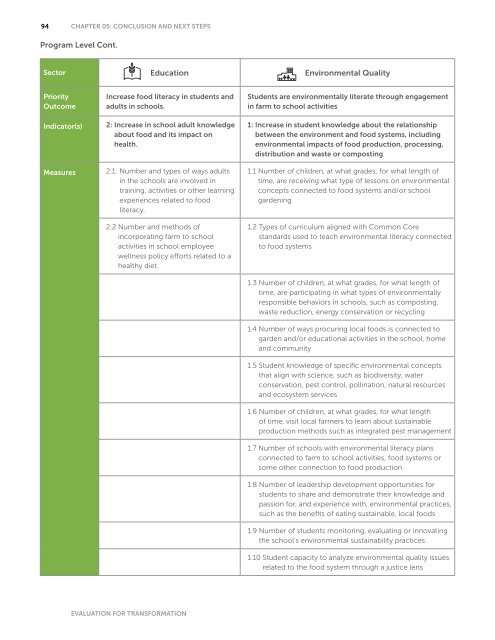Framework-08-25-14_web
Framework-08-25-14_web
Framework-08-25-14_web
You also want an ePaper? Increase the reach of your titles
YUMPU automatically turns print PDFs into web optimized ePapers that Google loves.
94 CHAPTER 05: CONCLUSION AND NEXT STEPSProgram Level Cont.Sector Education Environmental QualityPriorityOutcomeIndicator(s)MeasuresIncrease food literacy in students andadults in schools.2: Increase in school adult knowledgeabout food and its impact onhealth.2.1: Number and types of ways adultsin the schools are involved intraining, activities or other learningexperiences related to foodliteracy.2.2 Number and methods ofincorporating farm to schoolactivities in school employeewellness policy efforts related to ahealthy diet.Students are environmentally literate through engagementin farm to school activities1: Increase in student knowledge about the relationshipbetween the environment and food systems, includingenvironmental impacts of food production, processing,distribution and waste or composting1.1 Number of children, at what grades, for what length oftime, are receiving what type of lessons on environmentalconcepts connected to food systems and/or schoolgardening1.2 Types of curriculum aligned with Common Corestandards used to teach environmental literacy connectedto food systems1.3 Number of children, at what grades, for what length oftime, are participating in what types of environmentallyresponsible behaviors in schools, such as composting,waste reduction, energy conservation or recycling1.4 Number of ways procuring local foods is connected togarden and/or educational activities in the school, homeand community1.5 Student knowledge of specific environmental conceptsthat align with science, such as biodiversity, waterconservation, pest control, pollination, natural resourcesand ecosystem services1.6 Number of children, at what grades, for what lengthof time, visit local farmers to learn about sustainableproduction methods such as integrated pest management1.7 Number of schools with environmental literacy plansconnected to farm to school activities, food systems orsome other connection to food production1.8 Number of leadership development opportunities forstudents to share and demonstrate their knowledge andpassion for, and experience with, environmental practices,such as the benefits of eating sustainable, local foods1.9 Number of students monitoring, evaluating or innovatingthe school’s environmental sustainability practices1.10 Student capacity to analyze environmental quality issuesrelated to the food system through a justice lensEVALUATION FOR TRANSFORMATION


